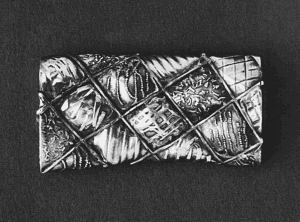Goldsmithing: Fusing Technique
When precious metal is heated to temperatures approaching its melting point there is a short span during which the outer layer or skin begins to melt while the interior remains solid. Or, to say the same thing technically, the interior remains in the solidus zone while the surface regions enter the liquidus range. The effects are to create an uneven reticulated surface and to allow pieces to join by welding. Every goldsmith discovers fusing, usually by accident and usually as a mistake, when pieces being soldered are overheated.
4 Minute Read
For years it was accepted in the field that the fusing technique was the result of poor craftsmanship and had no place in the jewelry world. In the 1950's, intentionally fused pieces were first shown, pieces that used the rich textures and spontaneous compositions that are part of the process. There was considerable resistance to this "technique" but it has now become adopted as yet another tool in the goldsmith's bag of tricks.
When precious metal is heated to temperatures approaching its melting point there is a short span during which the outer layer or skin begins to melt while the interior remains solid. Or, to say the same thing technically, the interior remains in the solidus zone while the surface regions enter the liquidus range. The effects are to create an uneven reticulated surface and to allow pieces to join by welding. Every goldsmith discovers fusing, usually by accident and usually as a mistake, when pieces being soldered are overheated.
The results of fusing are to some degree dependent upon chance but with some experience the creative effects can be anticipated and controlled. It is easy to distinguish work in which fusing is used for legitimate design purposes from pseudoartistic "works" in which handwork and design inabilities are masked by fusing.
| Figure 10.54 Silver and Gold Brooch. Chased fields with soldering and granulation. (Gabriele Putz, Magdeburg) | Figure 10.55 Silver Brooch Chased areas with textured and soldered designs. |
The Procedure
Because the process depends on localized heating it must be done with a torch, preferably one with a small hot flame. In the case of copper and brass an oxy-acetylene welding torch might be needed. The metal is placed on a clean soldering block, fluxed, and preheated overall. The flame is them played on the area to be joined or textured, typically with a gentle back and forth motion. The metal is brought through red to the flash point; the moment when the surface becomes fluid and shiny. At that moment the torch is abruptly taken away. This instant chilling causes the metal to contract and draw itself up into ridges.
| Figure 10.56 Silver Cuffinks with Faused Surface. (Erhard Brepohl, Bad Doberan) |
If several pieces reach the liquidus point at the same moment, they flow together just as several beads of mercury rolling on a table will merge if they come into contact. When the flame is removed these pieces are joined permanently. Edges tend to draw up on themselves, thickening and making a soft shape. Because of this it is necessary to start with a piece of metal slightly larger than the desired result.
As with other dramatic textures, the effect is often enhanced by using it selectively alongside smooth polished sections or when ornamented with gemstones. It is useful to bear in mind that fused elements can be soldered like any other metal. Because of the inherently chancy aspect of the process, it is sometimes prudent to switch from fusing to soldering when a particularly appealing texture or shape has been created.
| Figure 10.57 Gold Brooch with Fused Surface. (Herman Junger, Poring) |
Examples
In the cuff link shown in figure 10.56 a simple rectangle of silver sheet has been cut out with shears and heated with the flame until the edges rolled in and the surface drew itself up into folds. As can be seen with the brooch in figure 10.57, the same texture forms on gold sheet when fusing. The pin in figure 10.58 shows the effect of fusing metal filings onto sheet. Naturally the filings must be completely clean and free from impurities. Depending on the application of the torch, the filings can be made to draw themselves up into tiny granules (heat from above) or to fuse in their irregular shapes (heat from below). The process can be facilitated by coating the sheet metal with a layer of solder before applying the filings, and while this is strictly speaking no longer fusing, the effect is closer to the spontaneous nature being discussed here than it is to traditional soldering. Figure 10.59 is another example of this technique, here used on a panel that is then soldered into a fabricated brooch.
| Figure 10.58 Silver Brooch with Fused Filings. (Student work, school for Applied Art Heiligendam) |
| Figure 10.59 Silver Brooch with Fused Filings. (Student work, School for Applied Art Heiligendamm) |
Instead of filings other pieces of sheet and wire parts in any desired shapes can be fused on. A pre-condition is always that a concrete plan of design is realized and one does not depend upon just any old accidental shapes.
Lovely effects can be produced when pieces of wire or bits of sheet are fused to themselves and to each other. To make the pin shown in figure 10.60, a mesh of wire was crumpled together and fused with a mini-torch; the richness that is achieved is clear in the close-up photograph.
| Figure 10.60 Silver Brooch with Fused Wire Elements. |
| Figure 10.61 Silver Cuffinks. Wire elements fused with one another and the base plate. |
A similar result can be seen in the cuff links in Figure 10.61, but in this case the underlying sheet plays a more active role. By comparing this last example with the first (figure 10.56) it is possible to see the depth and complexity of form possible with fusing when it is studied with the same intensity as any other process.
You assume all responsibility and risk for the use of the safety resources available on or through this web page. The International Gem Society LLC does not assume any liability for the materials, information and opinions provided on, or available through, this web page. No advice or information provided by this website shall create any warranty. Reliance on such advice, information or the content of this web page is solely at your own risk, including without limitation any safety guidelines, resources or precautions, or any other information related to safety that may be available on or through this web page. The International Gem Society LLC disclaims any liability for injury, death or damages resulting from the use thereof.
The All-In-One Jewelry Making Solution At Your Fingertips
When you join the Ganoksin community, you get the tools you need to take your work to the next level.
Trusted Jewelry Making Information & Techniques
Sign up to receive the latest articles, techniques, and inspirations with our free newsletter.



